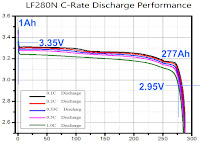As introduced in the previously corrected "Planning the Electrical & Energy System" post, Li-MO (Leaf 24KWh) or Li-NCM (Leaf 2017) or Li-NCA (Tesla) chemistries are not good candidates for most 12V applications.
Because their usable voltage range is either too low when using 3 cells in series (3S), or too high in 4S, to get access to the full battery's capacity. They work well for 24V, 48V, etc, but not for typical 12V cases.
LiFePo4, on the other hand, presents lower voltage characteristics that, in 4S, are perfect for 12V applications.
Let's start with Li-NMC
Here is the discharge profile for the Nissan Leaf's LMO cells from the 24KWh pack introduced in 2011. This source also provides great information on the Leaf pack and other chemistries.
This graph tells us a lot about how best to use that chemistry. For
instance, it is fully charged at ~4.2V. So charging it up to 4.1V should
be safe in most conditions (varies with temp, usage, Elon's latest tweet, etc) and help us avoid overcharging it.
It also tells us that below ~3.4V most of the capacity has been depleted, so that's a good protection threshold to avoid a deep discharge.
In other words, a good working range for LMO, that provides access to ~94% of the capacity, could be:
Which yields ~30.5Ah and a ~3.75V nominal voltage. Hence an approximated 30.5 x 3.75 = ~114Wh capacity per cell (depends on discharge rate, temp, where Waldo actually is, etc).
Note: we are cutting corners here, using napkin math instead of doing it perfectly. The latter requires calculating the surface under the curves. But...
So, accessing most of the capacity would require a 16.4 to 13.2V voltage range in 4S, and 12.3 to 10.2V in 3S. To be compared to 12V applications that at +/-15% tolerance support 13.8-10.2V, or 13.2-10.8V, at +/-10%.
Conclusion:
- 4S: the overlap in working voltage ranges is so small that most of the battery's capacity could not be accessed
- 3S: overlaps with 12V +2.5% / -15%. But that's before taking into account possible severe system limitations, like the Victron Multiplus inverter that stops generating 110V below 12.1V !
Now, I'll let you and Chuck do the same math for the Li-NCA chemistry. *** Spoiler Alert *** It is a shocker: same conclusion 😲
Enter LiFePo4
EVE 280Ah cell example:
The eyeballed nominal voltage @1C is ~3.2V, for a conservative ~276Ah. Resulting, in 4S, in a 13.4-11.8V voltage range and a capacity of 4 x 3.2 x 276 = ~3.5KWh. Winner !
And, crucially, LFP is much safer than Li-NMC or Li-NCA. In my book this is a must for any high power density DIY project. Especially in road applications where, in case of an accident, high kinetic energies and mangled electricals can be involved.
Hence my booking a flight to China, that pretty much has a monopoly on high volume large capacity LFP cells. Or, alternatively, I'll look into setting up an Alibaba account 😂
More on that in the next post...
____________________________________
<<< previous post: 1st Road Test Trip - Wyoming, here we come !






Comments
Post a Comment